A Magical World
By Michael Rutland
Photographs by Vince Heptig
Phoenix Scouts discover natural wonders above and below ground on their spring break adventure to southern Arizona.
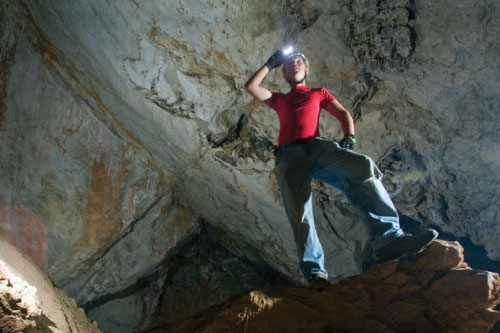 For Kyle Combes and Troop 109, the trip inside Arizona's Crystal Cave unlocked sights beyond imagination. |
From his rocky perch at Inspiration Point, Eagle Scout Kyle Combes gazed across the canyons of southern Arizona’s Chiricahua National Monument. Hiking with his buddies from Phoenix Troop 109, Kyle’s incredible view offered a great excuse to stop and catch a breath while tackling the park’s toughest trail: Big Loop. The boys and leaders savored the chilly air left by retreating storm clouds and watched slender ribbons of snow drift down and disappear into the ravine.
This was the third day of Troop 109’s spring break outing. And although the day hikes were challenging and the scenery beautiful, the trip’s main event was still in doubt.
Back in the planning stages, the Scouts researched hiking trails they could take from a centralized base camp. Then, committee chairman Keith Nissen and assistant Scoutmaster Brad Nabours asked if the boys wanted to visit a “wild” cave. The Scouts answered with an enthusiastic “Yes!” and the troop made arrangements to explore Crystal Cave.
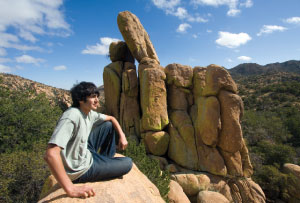 Eric Macias finds the high ground to take in the view of the Dragoon Mountains inside the Coronado National Forest. |
Caves are divided into two categories. “Show” caves, managed by private groups or government agencies, have walkways, decorative lighting, and guided tours. “Wild” caves, on the other hand, often just have openings in the ground with no paved trails or lighting. And sometimes, they have locked gates and require permission for entry.
That was Troop 109’s problem. They had permission to explore Crystal Cave, but the Forest Service’s key to unlock its gate hadn’t arrived before the group left Phoenix.
Would the Scouts forfeit a large part of their trip? Or could the troop’s leaders figure out another way to get the key?
A walk in the snow
That uncertainty lingered in the Scouts’ minds as they began their first hike in the Cochise Stronghold of the Coronado National Forest.
They followed a network of snaking paths that crossed the midsection of the Dragoon Mountain range and ran alongside giant slabs of pink-orange granite. The trail then meandered through thick stands of oak and juniper before ending at a dry creek bed. It was tough, but there was enough free time to absorb views of unexpected greenery.
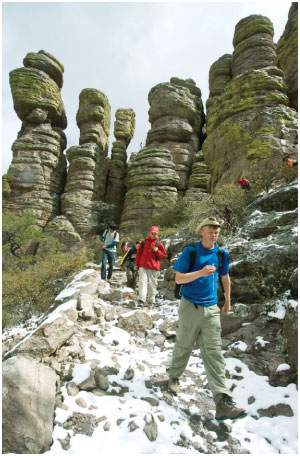 Kyle Combes leads the group's hike through the Chiricahua National Monument. |
“There are a lot more trees and plants than I was expecting,” said Brian Hickerson as he checked out the valley that stretched into the distance. “When you think of southern Arizona, you think of empty desert.”
The Scouts also were surprised that an area just a short drive from the Mexican border could have snow. A cold front had appeared on the horizon that afternoon and quickly turned the sky an iron gray. The temperature dropped and so did a sprinkling of the white stuff.
Shivering around the campfire that night, as spurts of powder continued to fall, the group brainstormed ideas for getting the key to Crystal Cave.
“We were at the make-or-break point,” Nabours recalled. “We had to make a decision.”
The next morning, Nissen drove three hours to the ranger station that managed Crystal Cave. Nissen knew that there was no guarantee he could get a key, but it was a last-ditch effort to save the day.
Meanwhile, the Scouts and other leaders headed to the Chiricahua National Monument. If the Cochise Stronghold’s abundance of vegetation challenged the notion that southern Arizona was all sand and scrubby cactus, this area eliminated it. The monument is part of a geological rarity called a “sky island”—an isolated series of mountains that rise above the surrounding grassland “sea.”
During the night, the storm that dusted the troop’s campsite swung east and stalled over the monument’s rock spires and canyons, depositing the bulk of its snow on the trails and formations. Drifts almost a foot deep appeared on either side of the road as the troop drove into the park, and more traced the edges of the area’s ponderosa pine, Engelmann spruce, and Soaptree yucca.
The Scouts picked Chiricahua’s Big Loop Trail because it passes through the park’s most scenic wilderness. In 9.5 miles of up-and-down hiking, the Scouts saw all the main sights: Echo Canyon, Heart of Rocks, Big Balanced Rock, and Mushroom Rock.
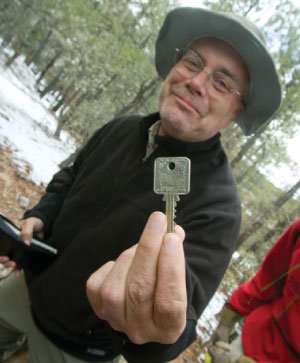 Shining moment: Keith Nissen is the day's hero after traveling to Tucson to find the key. |
But it was the sight of Nissen at the trail junction to Inspiration Point that most impressed the Scouts. Nissen wore a big smile and held something in his hand.
Was it? Yes! He had the key. Everyone exchanged high fives as Nissen recounted his trip to Tucson. The park ranger told him that a group of scientists had checked out the key and failed to return it. When he found out about the Scouts’ plight, he agreed to lend Nissen a spare key.
Underground wonders
The next day, the Scouts finally stood in front of the long-desired gateway to the underworld. It was a monster of bolts and welded steel that looked more appropriate for a bank vault than a barrier for a small crack in the earth.
Nissen unlocked the gate and the Scouts, wearing hard hats with headlamps attached, ducked through the opening and walked down a gravel slope. As their headlamps sliced through darkness as deep and still as outer space, the Scouts could see the edges of a room large enough to rival a European cathedral.
Passageways led off in all directions. Some were as narrow as a body’s width, and others were big enough to accommodate a school bus. And then there were the crystals. Pockets of calcite and gypsum sparkled everywhere.
“Totally amazing!” Zachary Goater said happily to his dad, Michael, after emerging from a chest-squeezing passage in the floor. Others heard Chris Nabours and his father, Brad, shouting to each other about exciting discoveries across the enormous main room.
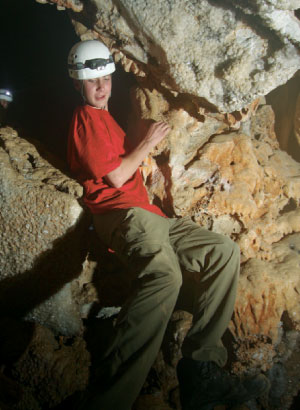 Once inside, it was a tight squeeze for Patrick Mitchell through some parts of the cave. |
Brian Hickerson and Patrick Mitchell gazed in wonder at an outcropping of sharp-edged “cave coral.” Eric Macias and Kyle played their lights over the room’s tall walls of “flowstone,” a pattern of rock that looks like an enormous melting candle.
As the group scrambled out of the cave several hours later, covered with dirt, scrapes, and sweat, everyone agreed that it was worth all the uncertainty and struggle.
“It was the best thing I’ve ever done in my life,” said Eric.
Patrick didn’t want to leave. “As soon as I came out, I wanted to go back in and see more,” he said, slapping dirt from his shirt and pants by the cave entrance.
“Yeah,” said Michael Goater, doing likewise. “That was incredible! When we sat down and turned off our headlamps, I could imagine how scary it would be to have your batteries die. You’d never find your way out.”
That’s why cavers always carry three sources of light and lots of fresh batteries.
The Scouts finished their trip by visiting nearby Kartchner Caverns, a commercial show cave. It contained rare formations that they hadn’t seen the previous day, including one of the world’s longest soda straw stalactites, “bird nest” formations of needle quartz, and the tallest and most massive column in Arizona.
“The reason the formations appeared so impressive [in contrast to those at Crystal Cave], Brian said, “was because the cave was lighted. I think Kartchner offered a more visual experience, while Crystal offered a hands-on, exploratory one.”
In one week, the Phoenix Scouts had experienced the natural beauty and adventure of two different worlds—above and below ground. And they most certainly learned that planning, patience, and perseverance are the keys to a successful outing.
Michael Rutland is an experienced caver and freelance writer in Austin, Tex.
Know Before You GoThe easiest way to start caving is to join a local club. There are hundreds throughout the nation. The BSA also offers guidelines on cave safety, under the “Sports and Activities” section of the Guide to Safe Scouting. Find all the information you need at: www.scouting.org/HealthandSafety/GSS/toc.aspx. |
Caves You Can VisitThe best place to see the underworld’s wonders is in a “show cave,” where you can also learn about its geology and how to protect its formations from damage. For a complete list, check out the National Caves Association at www.cavern.com. In the meantime, check out these fab five: Moaning Cavern of Vallecito, Calif., boasts the largest vertical chamber in a California public cavern. The entire Statue of Liberty could stand inside! Visitors can make an optional 165-foot rope rappel into the main chamber, and a challenging three-hour caving “adventure trip” encourages exploration. Natural Bridge Caverns near San Antonio, Tex., features a 75-minute walking tour through a half-mile of one of the most spectacular show caves in the state. For the more daring, the Adventure Tour provides a physically demanding excursion into an undeveloped cavern. Grand Caverns, Grottoes, Va., opened in 1806, makes it America’s oldest show cave. Gigantic stalactites hang from the ceiling, and stalagmites thrust upward from the rocky floor. Cathedral Hall, 280 feet long and more than 70 feet high, is one of the largest rooms of any cavern in the Eastern United States. Wind Cave National Park, Hot Springs, S.D., is as beautiful above ground as it is below. It contains one of the world’s longest and most complex caves and 28,295 acres of mixed-grass prairie, ponderosa pine forest, and associated wildlife. For two decades following its discovery in 1881, the cave was managed as a tourist attraction. But after a long legal battle between the owners, the federal government stepped in. On Jan. 3, 1903, President Theodore Roosevelt signed a bill creating Wind Cave National Park. It was the country’s eighth national park and the first one established to protect a cave. Meramec Caverns in Stanton, Mo., is one of 6,000 caves surveyed in the state. Located in the Meramec Valley, the caverns contain some of the largest and most unusual formations in the world, including an ancient limestone “Wine Table” and an entire seven-story mansion. |